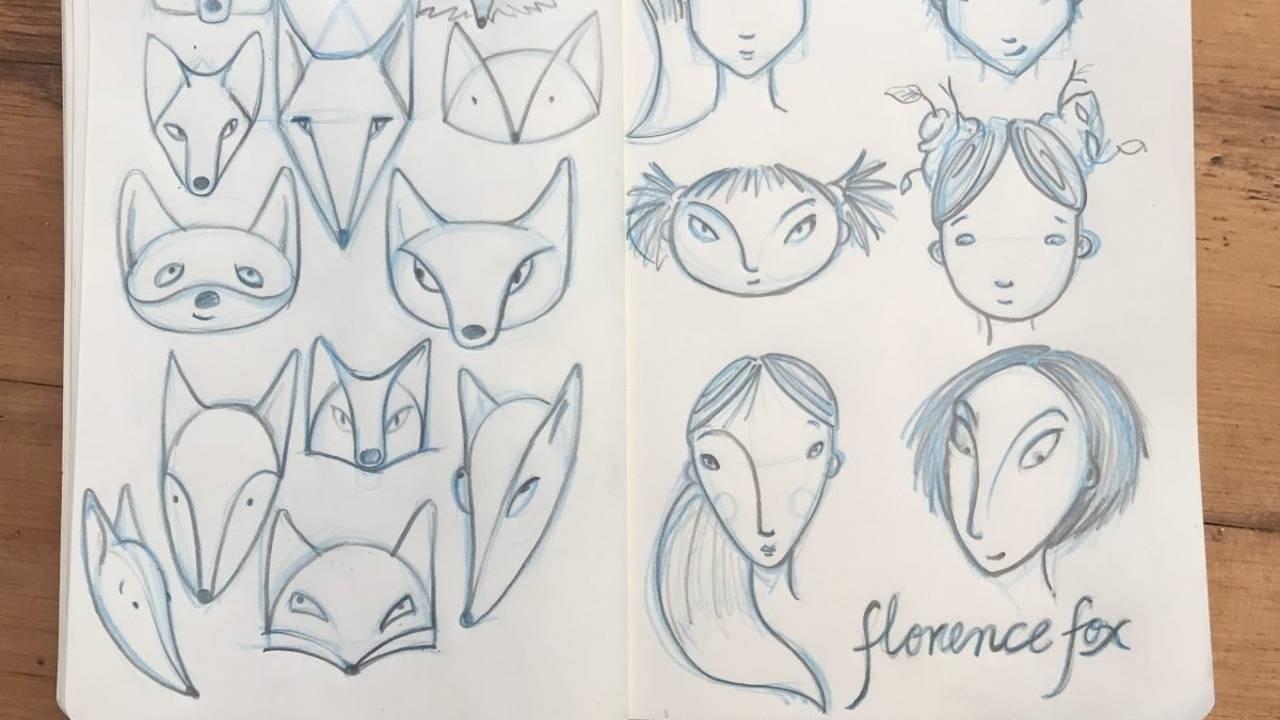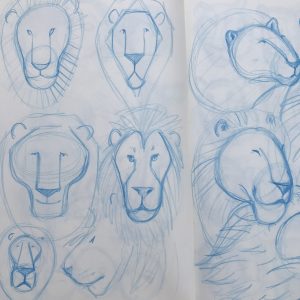How to use your sketchbook practice to help find your illustration style

A big part of being a children’s picture book illustrator is having the ability to draw well and being able to capture a character (or visual story) in your own unique ‘voice’. I’ve been illustrating picture books since 2000 and with more than a dozen publications worldwide, I now enjoy teaching everything that I’ve learned over the years …. from character design, storyboarding and illustration techniques. Here, I’m going to share with you the process that I use in keeping a regular sketchbook practice.
Drawing isn’t something that is handed to a selected few, drawing is a skill and a skill is something that can be taught and more importantly, learned. Anyone can learn to draw and anyone can learn to develop their own illustration/drawing style – it just takes time and practice. My sketchbook practice has helped me find, refine and develop my illustration style. What I’m about to share with you, will help you to do the same.


It may take only 20-mins a day, but my sketchbook practice is a place where I can experiment, explore (and make plenty of mistakes) without the pressure of deadlines, clients, and expectations. It’s a time when I can draw just for me. Having said this, over the years, many of my sketchbook ideas and drawings have managed to find their way onto the pages of my picture books.
Whether you’re a budding artist in search for your unique style or a seasoned illustrator feeling stuck, a regular practice can help you:
- connect you with your creative self
- find your illustration style
- develop your illustration style
- add to your ‘visual library’
- develop a character or reveal a new picture book idea!
Develop and maintain a regular practice
Becoming skilled at drawing requires a desire, instruction, practice, time, and more practice. My regular sketchbook practice has helped me connect with my creativity, find my illustration style, improved and maintain my drawing skill-set all the while adding to my ‘visual library’.
Below are the steps you can use when I don’t know where to begin. In a window of 20-mins:
- choose a theme, a story or a character idea
- look and then draw an animal or character using simple shapes
- draw a page of possibilities … and then when you think you’ve emptied every idea onto the page,
- then draw some more!
It’s in the ‘draw some more’ moments that the magic happens. This simple step-by-step process will help you move into your ‘sweet zone’… and this is the place where you will start drawing from your authentic place.
Use prompts
Here are some ideas to help you choose a character, theme or a story idea
IDEA JARS. A blank page can seem daunting at first, so I usually kick things off with a topic. I’ve either been thinking about a topic the day before or if I am truly stuck, I head to my trusty ‘idea jars’.

I have three mason jars titled ‘animal’, ‘action’ and ‘object’ with an item written on multiple slips of paper in each jar. Ideas that I can literally pull from – I’ll choose one animal (lion, tiger, fox, boy etc), one action (juggling, jumping, diving, floating etc) and one object (balloon, ribbon, wooden spoon, bath). Depending on time, I may only choose to dive into the ‘animal’ jar, if I have more time, I might decide to choose from the ‘animal’ and ‘object’ jars and if time allows, I’ll throw in an ‘action’ for good measure. (you can also add jars for ‘emotion’ and ‘setting’.
With practice, you’ll not only become familiar with a large variety of animals and objects but you’ll also strengthen your imagination and visual storytelling skillset. A giraffe in a bath … a hippopotamus floating away on a balloon … a polar bear eating ice-cream … the possibilities are endless and you can see how this can lead to picture book possibilities.

STORYTIME. If you don’t have your own story to work on, you may like to use a classic. Fairy Tales, Fables, and poems make for exciting inspiration and drawing practice. Edward Lear’s ‘The Owl and the Pussycat’ or perhaps a retake on Carlo Collado’s ‘Pinocchio’or maybe even try your hand at an Aesop Fable …the possibilities are endless!
Do it with others
Starting a regular sketchbook practice on your own can seem quite daunting at first, so why not sign up for the free sketchbook revival workshop and we can do this together! With 20 plus creative instructors (including myself!), you can join the Sketchbook Revival Facebook group to compare note, share your sketches and stay connected throughout the workshop.

In my Sketchbook Revival Workshop session (see below for more details about this free workshop), I’ll walk you through the steps I take in my sketchbook practice. I’ll be introducing you to one of Ben Whittaker-Cook’s characters from his picture book manuscript ‘Florence Fox Goes to School’ so that you can experience designing and exploring a story-driven character.
‘Due to a mix-up at the hospital one day, baby Florence went home with a pair of loving foxes instead of her real parents”.
The trick here is to find the perfect blend of fox and Florence.
Use reference to inspire
Reference is really important, especially if you’re not familiar with an animal or an object, however, as you build your visual library you’ll end up needing to use reference less and less and by pulling from your own memory, you’ll find your illustrations becoming more authentically you.
Everyone knows what a fox looks like … right? A pointy snout, triangular black-tipped ears, black socks, red fur with a white underbelly and a bushy white-tipped tail. But how big are the ears? How long/bushy is the tail?… What shape/size/ color are the eyes?

In my Sketchbook Revival session, I’ll be focusing on the face of the fox face (facing front-on), however, once you’ve nailed the face, you may like to try drawing the entire body … and then experiment drawing the fox from different angles.
Draw from the inside-out, not from the outside-in
When illustrating characters for a picture book, drawing from photographs is an absolute no, no! As an illustrator, you need to be able to draw a character over and over again, in multiple positions and from every possible angle. So instead of drawing from the outside-in (drawing from reference), you need to be able to draw your characters from the inside-out (from a place of feeling and emotion). So how do you get there?

Make sure that you gather multiple references from different sources, looking at a wide variety of reference will steer you away from copying. So, if I’m to draw a fox/girl, I’d start by gathering multiple fox images… as many as I can find. Google is a great place to start, but what about small plastic toys, logos, posters, paintings … a visit to the zoo!
Look for shapes
Everything in the world can be simplified into basic shapes. In my Skillshare classes, Face Shapes – Explore Character Using 9 Simple Shapes and Draw a Circus of Characters I talk about this in more depth. But basically, when you’re studying a subject (or an object), try to pick out the basic shapes that make up the overall shape. Usually, these shapes are pretty easy to draw. Draw the shapes then draw the contours, the outlines.


Use the reference as just that … reference. Scan your eyes over all of your references and start looking for simple shapes (here I’ll be focusing on the fox face). If it helps, try squinting your eyes slightly, so that the images are blurred because you are no longer distracted by the detail, you can more easily start seeing the simple shapes. If I scan my fox reference, I can see square and diamond-shaped faces. There are also oval, half circle and teardrop-shaped face too.
Start off by drawing the shapes that you see, What shape are the eyes? Where do they sit on the face? Are they wide-set of close-set? How big/small are they? The snout… is it round tipped, square-tipped or pointy? Where does the snout begin? Where does it finish? How does the snout work with the eyes…the forehead? What about the mouth, how does the jaw sit against the snout? Is the mouth large, small, how far back does it go? What shape and size are the ears? How do they sit on the head? How wide/pointy are they? Understanding every aspect of the animal in great detail will not only add to your visual library for later but you may find yourself being inspired by the shapes, contours (lines) and how one part connects to another.

Draw from your drawings
This is where the fun begins, it’s now time to place your reference to one side and to solely rely on your drawings (and memory). Drawing from your drawings brings you one step closer to drawing from the inside-out and one step closer to finding your illustration style.
In my sketchbook Revival session, I show you how to move from drawing fox faces to drawing a mix of girl/fox (inspired by your fox drawing).
So, looking your fox face drawings … what shapes can you see? …and how can you transfer these into a human girl character. Is it the face shape, the pointy nose, the almond eyes? Perhaps it’s where the facial features sit on the face. Are the eyes, small and wide-set. Or large and high on the head? Perhaps it’s the skin/eye and hair coloring?

Experiment merging different fox attributes into a girl character. Once you’ve completed the girls face, you may then like to do the same thing with her entire body.
Relax
When you are drawing, make sure to relax, if you’re stressed or tight, your line-work will also look stressed and tight. When you are trying to define the contour of a subject or an object, draw several light lines. You have a better chance of finding the right line when you draw several of them. Try holding the pencil differently than how you hold it when you write. Draw with your shoulder instead of your wrist by moving your whole arm when you make a mark. I like to use a warm-up page, then, by the second and third page, I’ve hit the sweet spot.

Get lost in order to find your authentic style
Getting lost in the process is the gateway to finding your authentic style. At first, it may seem like you’re drawing a simple dot-to-dot, but within minutes ideas will start to flow. The shapes, are there to help you get started, and the reference is there to help you understand the details and basics of your chosen animal. As your confidence (and play) grows, you’ll find yourself getting ‘lost’ in the process … and it’s in the getting lost moments that you can potentially find your authentic illustration ‘voice’.
Practice, Practice, Practice
Practice, Practice, Practice, and then – Practice Some More! I cannot say this enough, drawing is skill and like any skill, it takes time and practice, so start by keeping a sketchbook and make sure to draw every day.
And remember, whether you want to keep your practice personal or share the experience with others, a regular practice will help you:
- connect you with your creative self
- find your illustration style
- develop your illustration style
- add to your ‘visual library’ … and it may just reveal new characters or even a picture book idea.



